As an Amazon Associate, we earn from qualifying purchases with no additional costs for you.
Knives are an indispensable tool in every kitchen, aiding in everything from dicing vegetables to carving meats. However, if not stored correctly, their sharp edges and pointed tips pose a significant safety risk. Securing knives in a kitchen is a crucial aspect of knife safety for chefs, cooks, or even children who may venture into the kitchen environment. What are the best ways to lock up knives in the kitchen?
Locking up knives in the kitchen or securely storing them has two main purposes. Correct storage protects the knife user or anyone using the kitchen and protects the knife to preserve sharpness and extend the knife’s longevity. Securing knives in the kitchen is part of responsible knife ownership.
Whether you’re a professional chef, an avid home cook, or someone who occasionally whips up a meal, ensuring that your knives are safely tucked away is paramount. Not only does proper storage prevent accidental injuries, but it also preserves the longevity and sharpness of your knives, ensuring they’re always ready for the next culinary task. In this guide, we will share the various methods of safely storing knives in the kitchen, highlighting traditional and modern solutions catering to different needs and spaces.
If you are interested in checking out an in-drawer knife block we recommend and use for safe knife storage, you can find it by clicking here (Amazon link).
The Need For Proper Kitchen Knife Storage

The importance of safely storing knives cannot be overstated in the bustling kitchen environment, where multitasking is the norm.
Proper knife storage is a necessity, whether it’s the risk of accidental cuts, children reaching for shiny objects, or the simple wear and tear on your precious blades. Let’s explore why safe storage is imperative for your kitchen knives.
Kitchen Knife Safety Concerns
Several safety aspects must be considered when storing kitchen knives safely.
- Children and Pets: One of the primary concerns in many households is the safety of children and pets. A knife left on a counter or in an easily accessible drawer can lead to severe injuries. Properly locked up or secured knives ensure that curious hands and paws stay safe.
- Accidental Injuries: Even for adults, a misplaced knife in a drawer or one teetering on the edge of a counter can lead to unexpected cuts. Having a designated and safe storage space can minimize such accidents.
Preservation Of Knife Quality
Improper or unsafe storage of your kitchen knives can compromise the knife edge and affect how long the knife will remain effective in your kitchen.
- Blade Sharpness: Knives tossed into a drawer or unwashed can quickly become dull. Using designated blade protectors or cork-lined knife holders can help maintain the blade’s sharpness, ensuring efficient cutting and slicing.
- Longevity: Proper storage can also extend the life of your knives. You can minimize wear and tear by preventing them from rubbing against other utensils or being exposed to moisture.
Organizational Benefits
Knowing where to find the right knife when you need it will ensure you always use the right one rather than using an inappropriate one. This can reduce the knife’s life expectancy and pose safety issues for the knife user.
- Easy Access: Knowing exactly where each knife is can speed up the cooking process. Whether it’s a magnetic knife strip or an in-drawer knife holder, organized storage solutions ensure you can quickly grab the right knife.
- Maximized Space: Especially in smaller kitchens, space is at a premium. Innovative storage solutions can help maximize counter and drawer space, making the kitchen look tidier and more spacious.
The need for proper knife storage goes beyond just aesthetics. It’s a blend of safety, preservation, and organization, ensuring a smooth kitchen experience for everyone involved.
TIP: Packing knives for moving requires care and attention to adequately protect your knives. We have a guideline below with expert tips for packing your knives when it is time to move.
Packing Kitchen Knives For Moving (7 Proven & Safe TIPS)
Traditional Vs. Modern Knife Storage Solutions
The evolution of kitchen design and tools has brought about many ways to store knives. While traditional methods have their charm and functionality, modern solutions offer innovative and often space-saving alternatives. Let’s explore both and understand their pros and cons.
Traditional Knife Storage Solutions
- Knife Blocks: These are wooden or plastic blocks with pre-cut slots to fit knives of different sizes. They are often placed on countertops and come with knife sets.
- Drawer Inserts: These are wooden or plastic trays designed to fit inside kitchen drawers. They have slots or compartments to hold each knife securely.
- Magnetic Wall Strips: While they’ve been around for a while, these strips allow knives to be hung on a wall, keeping them within easy reach.
Examples Of Modern Knife Storage Solutions
- Magnetic Knife Racks: An evolution of the magnetic strip, these racks can be mounted under cabinets or on walls and often feature a blend of wood and metal for a sleek look.
- In-Drawer Knife Mats: Flexible, silicone mats with grooves that can be placed inside drawers, allowing knives to be laid flat and separated.
- Under-Cabinet Drop-Down Holders: These innovative holders are installed under kitchen cabinets and can be pulled down to access knives and then pushed back up to save space.
| Comparison of Traditional vs. Modern Knife Storage Solutions | ||
| Criteria | Traditional Solutions | Modern Solutions |
| Space Utilization | Often requires countertop space (e.g., knife blocks). | Designed to save space (e.g., under-cabinet holders). |
| Accessibility | Generally easy to access, especially wall strips. | Offers quick access with innovative placements. |
| Aesthetics | Classic, rustic look (e.g., wooden blocks). | Sleek, contemporary designs blending various materials. |
| Flexibility | Limited to the design (fixed slots in blocks). | More adaptable to different knife sizes and numbers. |
| Safety | It is reliable but may expose blades in some designs. | Often designed with added safety features like blade protectors. |
In essence, while traditional storage solutions offer tried-and-true methods, modern solutions bring in adaptability, space efficiency, and often enhanced safety.
Depending on your kitchen’s design, space constraints, and personal preferences, you can choose a mix of both to create the perfect storage system for your knives.
TIP: If you are interested in buying a Japanese knife, we recommend these knives (Amazon links):
- Santoku: Yoshihiro NSW Hammered Damascus Santoku
- Gyuto: Yoshihiro VG-10 Hammered Damascus Gyuto
- Nakiri: Yoshihiro Hammered Damascus Nakiri
Magnetic Knife Strip: The Space-Saver
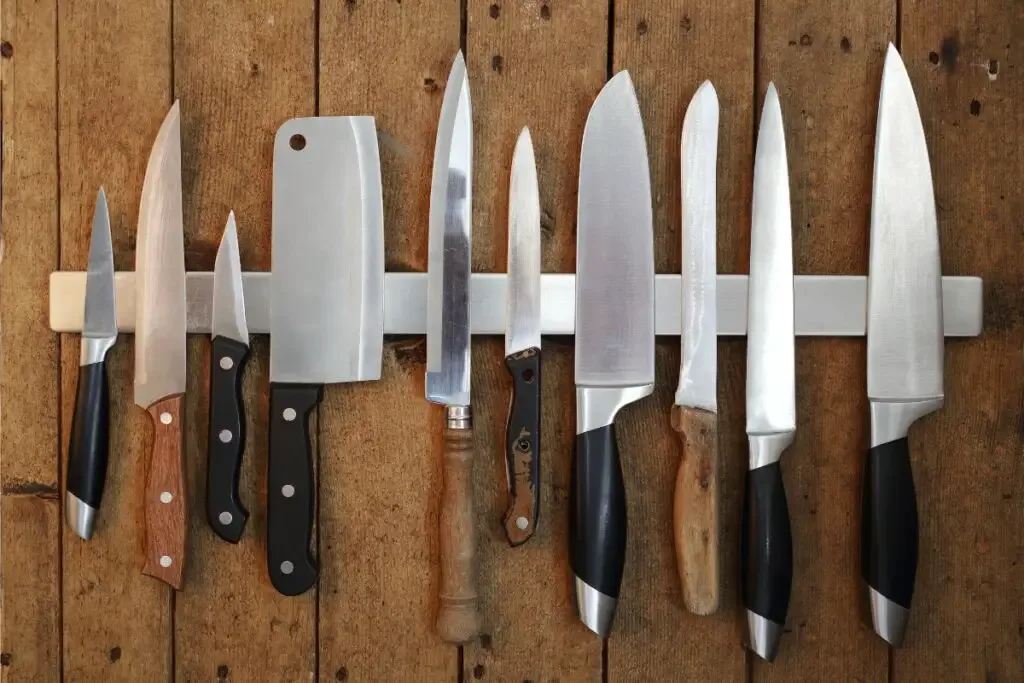
Among knife storage options, the magnetic knife strip stands out as a favorite for many, and for good reasons.
Not only does it offer a sleek and modern aesthetic to any kitchen, but it also provides a practical solution to the common problem of space constraints. Let’s explore magnetic knife strips and discover why they’re such a hit.
What Is A Magnetic Knife Strip?
A magnetic knife strip (Amazon link), often made of stainless steel or a combination of wood and metal, is a long, narrow strip embedded with strong magnets. It’s designed to be mounted on a wall, allowing knives to be hung magnetically by their blades.
Benefits Of Using A Magnetic Knife Strip
A magnetic strip for knife storage has many benefits, which contribute to the continued popularity of this knife storage method.
- Space Efficiency: These strips free up valuable real estate by utilizing vertical wall space, especially in smaller kitchens where counter space is a luxury.
- Visibility and Accessibility: With knives displayed openly, spotting and grabbing the exact knife you need is easier, speeding up the cooking process.
- Hygiene: Unlike knife blocks, where the insides can collect dust and debris, magnetic strips are open, ensuring that your knives don’t harbor hidden contaminants.
- Versatility: Beyond knives, these strips can hold other metal kitchen tools, such as scissors or peelers, keeping them within arm’s reach.
Magnetic Knife Strip Safety Guidelines
While magnetic knife strips have distinct benefits, some safety guidelines should be considered when using this kitchen knife storage method.
- Height Matters: Install the strip at a comfortable height, ensuring that it’s neither too high to reach nor too low to pose a safety risk.
- Safe Distance: Ensure it’s installed away from high-traffic areas to prevent accidental bumps that could dislodge a knife.
- Strong Fixation: Use sturdy screws and, if possible, fix the strip to wall studs to ensure it can bear the weight of all your knives.
- Blade Safety: Some users worry about the magnetic pull affecting the blade’s sharpness. However, with proper placement and gentle handling, this risk is minimal.
The magnetic knife strip (Amazon link) is a blend of form and function, offering a space-saving solution without compromising on accessibility or aesthetics. Whether you have a compact kitchen or are looking for a modern touch, this storage method is worth considering.
The Versatility of Cork-lined Knife Holders
Regarding knife storage, cork-lined knife holders have emerged as a unique and versatile solution. At first glance, they might seem like a simple adaptation of traditional storage methods, but explore a little deeper, and their benefits become evident.
Cork-lined knife holders (Amazon link) are typically designed as trays or blocks, with the primary difference being using cork as the lining material.
This natural material offers a soft cushion for the blades, ensuring they remain sharp and undamaged. The flexibility of cork also means that it can adapt to knives of various sizes, providing a snug fit for each blade.
One of the standout advantages of cork-lined holders is the protection they offer. Unlike hard surfaces that can potentially chip or dull a knife blade, cork provides a gentle resting place. This ensures that every time you pull out a knife, it’s as sharp and efficient as the last time you used it.
The aesthetic appeal of cork-lined holders shouldn’t be overlooked. Cork brings a warm, natural touch to any kitchen, blending seamlessly with both modern and traditional decors. Its neutral tone complements various knife designs, ensuring that your storage solution is functional and visually pleasing.
Cork is known for its antimicrobial properties, making it a hygienic choice for knife storage. It naturally repels moisture, reducing the risk of mold or bacterial growth, which is especially crucial in the damp environment of a kitchen.
In terms of maintenance, cork-lined holders are relatively hassle-free. Occasional cleaning with a damp cloth keeps them in top condition. And if the cork lining ever wears out, it’s often replaceable, ensuring longevity for your storage solution.
PRO TIP: We personally use diamond plates by Atoma. They are quite expensive but of the top quality with very long service life.
The initial costs are higher but you have an option of buying replacing diamond skin for all Atoma plates. The costs of replacing diamond skin are much lower than the cost of buying a new diamond plate.
So if you are going to use diamond plates regularly and want to get the best quality on the market, check out the four Atoma diamond plates listed below (Amazon links).
- Atoma Diamond Sharpener Coarse Grade 140 Grit
- Atoma Diamond Sharpener Medium 400 Grit
- Atoma Diamond Sharpener Fine 600 Grit
- Atoma Diamond Sharpener Super Fine 1200 Grit
These 4 diamond sharpening stones are all you need to have for repairing or sharpening your knives.
Rethinking The Knife Block
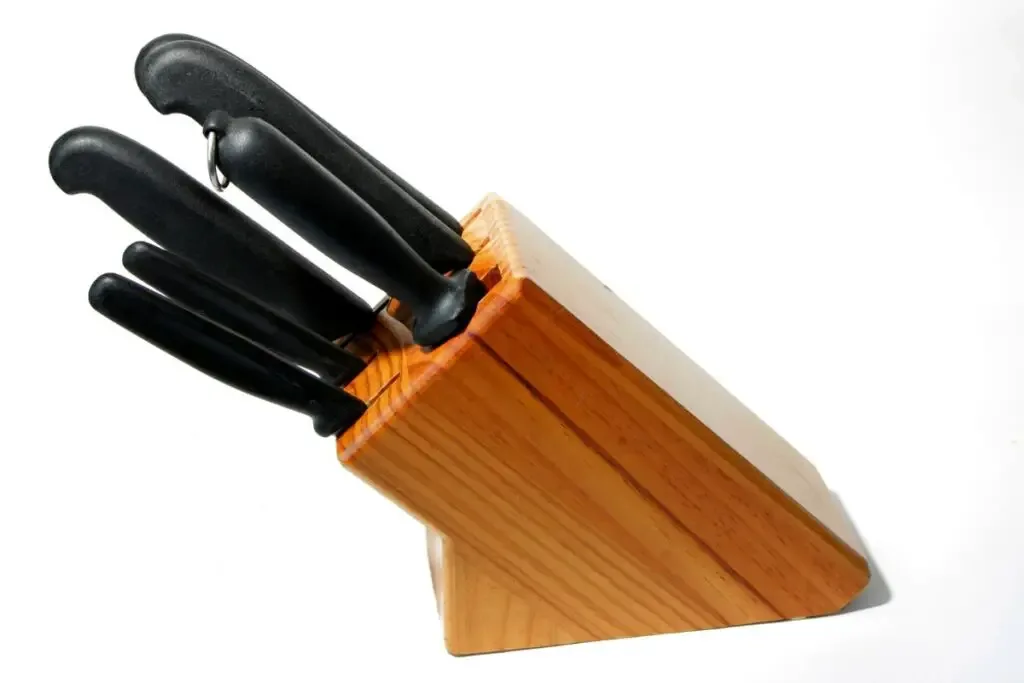
The knife block, a staple in many kitchens, has long been the go-to solution for storing knives. Its sturdy build and designated slots for each knife offer a sense of order and tradition.
However, as kitchen designs evolve and new storage solutions emerge, it’s worth reevaluating the classic knife block and considering its place in the modern kitchen.
Traditionally, knife blocks are made of wood, with pre-cut slots designed to fit a specific set of knives. While this ensures that each knife has its place, it also poses limitations.
If you purchase a new knife that doesn’t fit the existing slots, finding a suitable storage spot can be challenging.
Additionally, the fixed design means that as knives wear out or get replaced over time, the block might end up with empty slots or become incompatible with your current set of knives.
Another concern with traditional knife blocks is hygiene. The enclosed slots can trap moisture, food particles, and dust, creating a breeding ground for bacteria.
Unless regularly cleaned – a task that’s not always straightforward given the narrow slots, knife blocks can become a hidden source of contamination.
However, it’s not all drawbacks. Knife blocks are undeniably sturdy and provide a level of safety by keeping sharp blades shielded. Their countertop presence also offers easy access, making the cooking process smoother.
Aesthetically, a well-crafted knife block can add a touch of elegance and tradition to a kitchen, serving as both a functional tool and a decorative piece.
Modern adaptations of the knife block aim to address some of its limitations. For instance, some designs now feature flexible rods instead of fixed slots (Amazon link), allowing for a more customizable storage solution. Others incorporate materials like cork or removable liners to enhance hygiene and ease of cleaning.
While the traditional knife block has its merits, it’s essential to recognize its limitations in the context of contemporary kitchen needs.
By rethinking the knife block, we can utilize modern designs that offer flexibility, hygiene, and aesthetics, ensuring this classic storage solution remains relevant and efficient in the modern culinary space.
In-Drawer Knife Storage Solutions: Hidden But Accessible
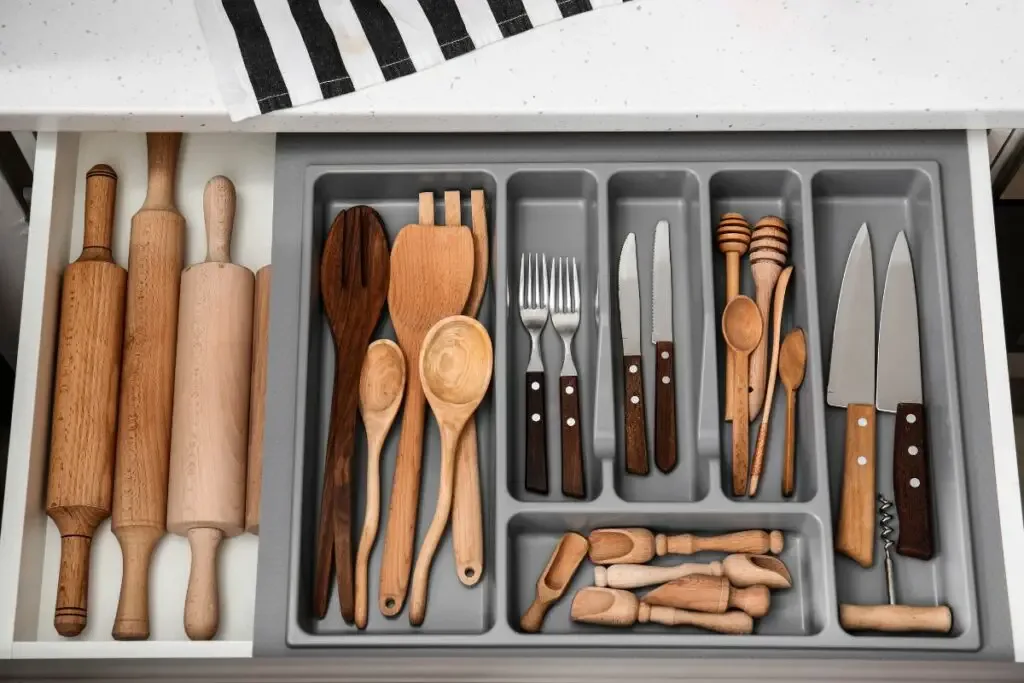
In the quest for a clutter-free kitchen countertop, in-drawer knife storage solutions have gained popularity. These solutions offer a blend of safety, organization, and aesthetics, ensuring that your knives are both out of sight and within easy reach.
However, choosing the right in-drawer knife storage option is key for personal safety and preserving your knives.
Some key features that promote in-drawer knife storage popularity are as follows.
- Concealed Storage: By storing knives inside a drawer, you maintain a clean and tidy countertop, enhancing the overall aesthetics of your kitchen.
- Safety: With blades tucked away, there’s a reduced risk of accidental cuts, making it especially safe in households with children or pets.
- Space Optimization: In-drawer solutions often come with designated slots or compartments, ensuring each knife has its place maximizing drawer space.
In-drawer knife storage solutions come in a variety of formats.
- Wooden or Plastic Trays: These are compartmentalized trays designed to fit inside standard kitchen drawers. They come with pre-cut slots or grooves to accommodate various knife sizes.
- Cork-Lined Mats: Flexible mats with grooves, offering the added benefit of cork’s protective and antimicrobial properties.
- Magnetic Drawer Inserts: These combine the benefits of magnetic strips with in-drawer storage, ensuring knives stay in place even when the drawer is opened or closed.
| Comparing In-Drawer Knife Storage Solutions | ||
| Type | Pros | Cons |
| Wooden/Plastic Trays | Sturdy, traditional look, fits most standard drawers. | Fixed slots may not accommodate all knife sizes. |
| Cork-Lined Mats | Flexible, protective, antimicrobial properties. | It might require occasional cleaning or replacement. |
| Magnetic Drawer Inserts | Secure hold, adaptable to different knife sizes, combines magnetic and in-drawer benefits. | It might be pricier than other in-drawer solutions. |
The following considerations should be kept in mind for in-drawer knife storage.
- Drawer Size: Ensure that the storage solution fits comfortably within your drawer, with enough depth to accommodate larger knives.
- Knife Accessibility: While keeping knives hidden is essential, they should also be easily accessible. Consider solutions that allow you to see and reach each knife without rummaging.
- Maintenance: Opt for solutions that are easy to clean and maintain, ensuring longevity and hygiene.
TIP: A sharp knife is a dangerous knife, and incorrect storage can dull your knives. Read our article on the best tools to have to keep your knives sharp!
3 Must-Have Tools To Sharpen Your Knife Properly (Answered)
Portable Solutions: The Knife Bag
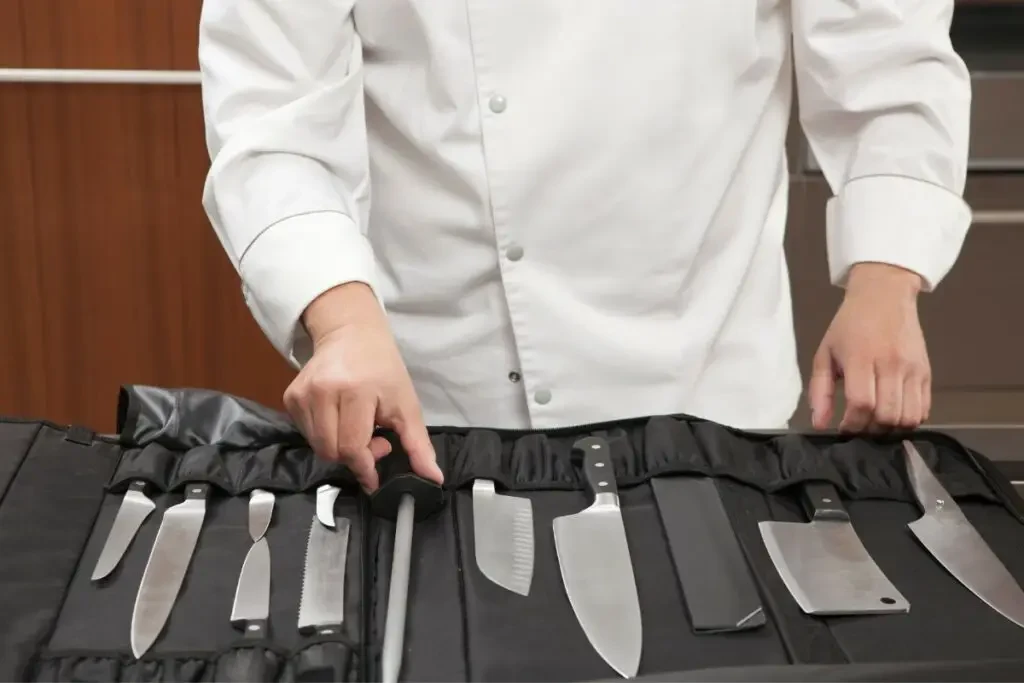
For culinary professionals, students, or enthusiasts who often find themselves cooking in various locations, the need for a portable knife storage solution is paramount. Enter the knife bag, a versatile and compact solution designed to safely transport a collection of knives and other essential tools.
A knife bag, often called a chef’s roll or knife roll, is a foldable pouch with multiple slots or compartments to house knives and other kitchen tools. Generally made from canvas to leather materials, these bags are designed to offer protection, organization, and easy transport.
| Types of Knife Bags (Amazon links) | ||
|---|---|---|
| Bag Type | Pros | Cons |
| Canvas Knife Bags | Lightweight, durable, and often water-resistant. They are also relatively affordable. | It might not offer as much rigidity or protection as other materials. Over time, they may wear out faster. |
| Leather Knife Bags | Aesthetically pleasing with a classic look. They offer excellent durability and protection for the knives. | Tend to be heavier and might require more care and maintenance to keep the leather in good condition. |
| Synthetic Material Bags (nylon or polyester) | Lightweight, water-resistant, and often comes with additional pockets or compartments. They are also generally more affordable than leather options. | It might not be as durable as canvas or leather in the long run. |
| Hard Case Knife Bags | Offer maximum protection with a rigid exterior. It is ideal for those who travel frequently or want added security for their knives. | Heavier and bulkier than soft bags. They might also be pricier. |
Some key aspects to remember when selecting a knife bag as storage for your knives are as follows.
- Size & Capacity: Depending on your collection, choose a bag that can accommodate all your knives and tools without overcrowding.
- Protection: Ensure the bag has adequate padding or lining to protect the blades and prevent them from rubbing against each other.
- Security: Look for bags with secure closures, such as zippers or buckles, to ensure everything stays in place during transport.
- Maintenance: Some bags might require more care than others, depending on the material. Consider how much time you’re willing to invest in maintenance.
TIP: We have some storage and organizational tips and hacks for your kitchen knives detailed in the article below!
Storing & Organizing Kitchen Knives: 5 Proven Tips & Hacks
The Elegance Of Saya: Wooden Sheaths
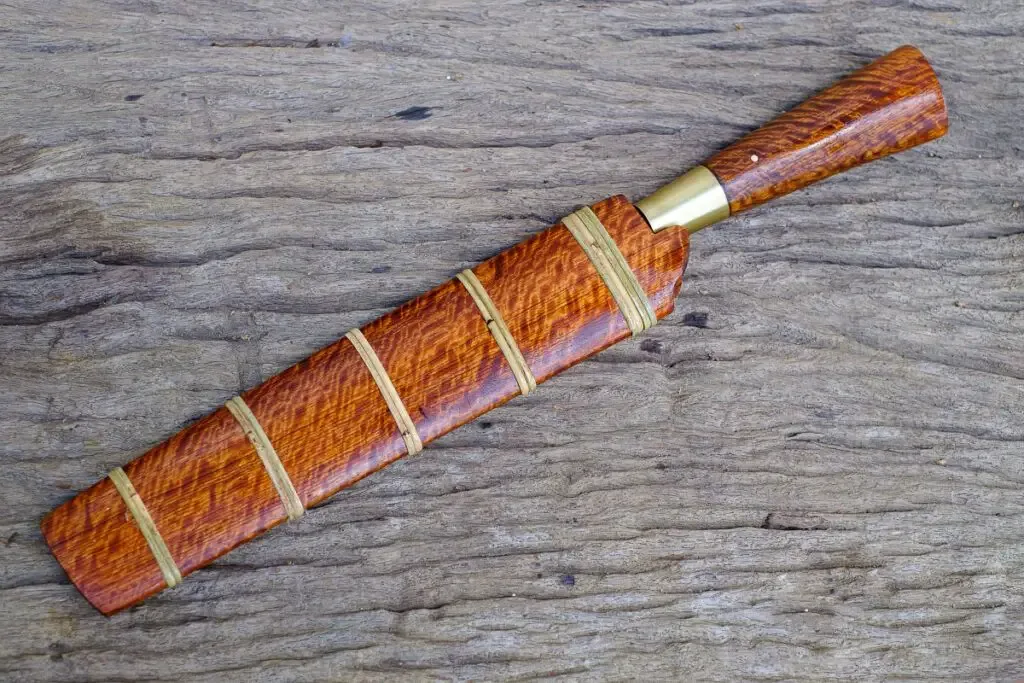
Originating from Japan, the Saya, or wooden sheath, is a testament to Japanese culture’s meticulous craftsmanship and reverence for knives. A Saya is a custom-fitted wooden sheath designed to encase and protect individual knife blades.
Crafted from lightweight wood, often magnolia or hinoki, the Saya snugly envelops the blade, shielding it from external elements and potential damage. Its design is simple yet purposeful, ensuring that the knife is not only protected but also presented elegantly.
Each Saya (Amazon link) is tailored to fit a specific knife, ensuring maximum protection. This precision ensures that the blade is held securely, preventing any movement that could lead to damage.
The use of natural wood offers inherent moisture-wicking properties, which helps prevent blade rusting or corrosion. With the blade fully encased, the risks of accidental cuts or injuries are significantly reduced.
It is important to remember the following if you are considering using a Saya for safe knife storage.
- Blade Protection: The primary purpose of a Saya is to protect the knife blade from external factors, ensuring it remains sharp and undamaged.
- Aesthetic Appeal: The natural wood grain, combined with the sleek design, adds an element of elegance to knife storage.
- Portability: With the blade safely encased, transporting knives becomes safer and more convenient.
- Maintenance: Wood, being a natural material, requires care. Regularly oiling and cleaning the Saya ensures it remains in good condition and prolongs its usable lifespan.
- Fit: It’s crucial to ensure that the Saya is a perfect fit for your knife. A loose or overly tight sheath can be counterproductive.
The Saya embodies the essence of traditional knife care, offering a storage solution that is both functional and aesthetically pleasing. For those who value their knives and wish to store them with reverence, the Saya provides an option that is steeped in tradition and elegance.
A modern take on the Saya is a knife guard made out of synthetic materials and designed to fit a wider range of knives. The principle of a knife guard is the same as the Saya: to provide individual knife protection and safety.
Conclusion
Knife storage and care are paramount for safety in the kitchen. But beyond the methods and materials, the underlying theme of the knife storage solutions we have discussed has been clear: safety and care.
Whether you’re a professional chef with a collection of artisanal knives or a home cook with a few essential blades, it is crucial to ensure they are stored safely, maintained regularly, and handled with care.
The choice of knife storage solution will depend on individual needs, kitchen space, and personal preferences. But regardless of the method chosen, the principles remain the same: protect the blade, ensure safety, and treat each knife with the respect it deserves.
TIP: Proper kitchen knife storage is important, but rust prevention is another crucial part of knife maintenance. We have 6 expert tips in the article below to help you keep your kitchen knives rust-free!
6 Proven Ways On How To Prevent Rust On Kitchen Knives
